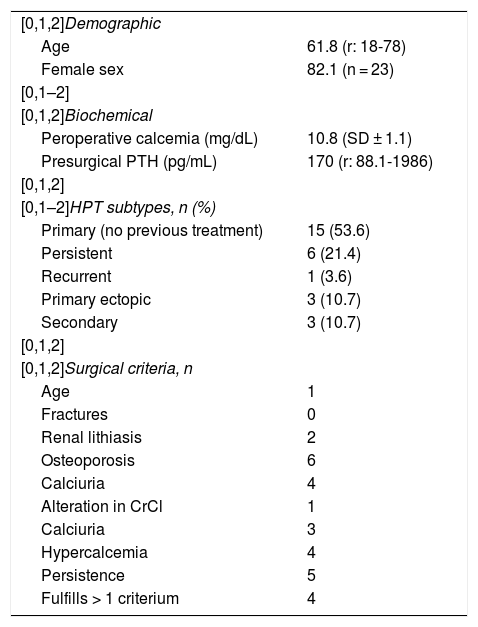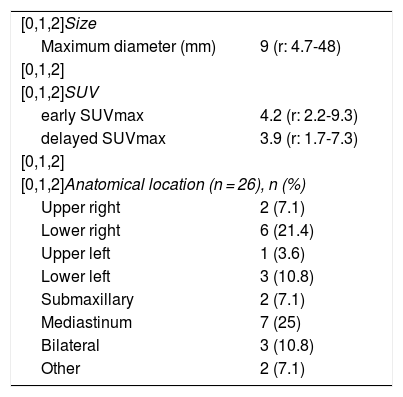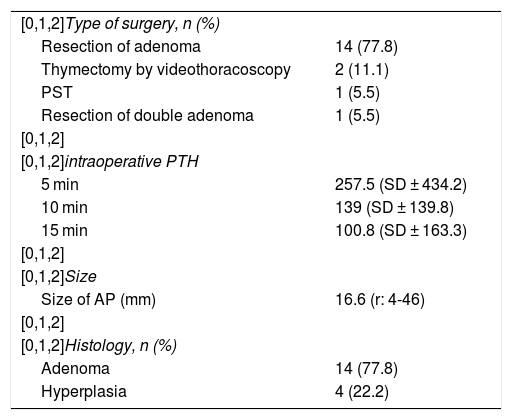Hyperparathyroidism (PTH) is characterised by increased levels of parathyroid hormone (PTH), surgical excision being the only definitive curative option. After establishing the need for surgery, it is essential to identify the parathyroid glands in the preoperative period to use a minimally invasive approach. Negativity and / or discrepancy in first- line studies (ultrasound and Tc-99 m MIBI parathyroid scintigraphy) require more accurate images to reduce the likelihood of bilateral cervical exploration or reintervention.
Objectivesa) To demonstrate the sensitivity of 18 F-fluorocholine (18 F-choline) positron emission tomography (PET)/4D computed tomography (4D CT) in HPT. b) To check whether there is a correlation between calcaemia and preoperative PTH versus size and early and late SUVmax (Standardized Uptake Value) of the gland, determined by 18 F-choline PET/4D CT and c) to study the behaviour of parathyroid lesions with intravenous contrast (IV).
Material and methodsA total of 28 patients were included between 2016 and 2019 in a single institution. Prospective observational cohort study. Correlations were analysed using Pearson's coefficient for variables with normal distribution and Spearman (rho) for those with non-normal distribution. Anatomopathological analysis was the benchmark standard to determine sensitivity was. A p < .05 was interpreted as significant. STATA 13 software was used.
ResultsOf the 28 patients who underwent 18 F-choline PET/4D CT, 18 were operated. Of the 26 lesions diagnosed by 18 F-choline PET/4D CT as suggestive of parathyroid lesions, 23 corresponded to glandular disease (adenoma or hyperplasia) establishing a sensitivity of 88.5%. There was a correlation between the patient's preoperative PTH and the maximum size of the gland on 18 F-choline PET/4DCT. (Spearman .66; p = .0014). The parathyroid lesions showed, in addition to IV contrast enhancement, distinctive behavioural characteristics identified as highly suggestive.
Conclusions18 F-choline PET/CT 4D is an anatomical and functional study with high sensitivity in patients with HPT with negative or discrepant first-line studies. Preoperative PTH showed a correlation with maximum gland size on 18 F-choline PET/CT 4D. Parathyroid lesions behave in a highly suggestive way and are enhanced by IV contrast.
El hiperparatiroidismo (HPT) se caracteriza por el aumento de los niveles de parathormona (PTH), siendo la exéresis quirúrgica la única opción curativa definitiva. Luego de establecida la necesidad de cirugía, la adecuada identificación de las glándulas paratiroides en el preoperatorio resulta esencial para un abordaje mínimamente invasivo. La negatividad y/o discordancia en los estudios de primera línea (ecografía y centellograma de paratiroides Tc99 m-MIBI), exige imágenes de mayor precisión, para reducir la probabilidad de exploración cervical bilateral o reintervención.
Objetivosa) Demostrar la sensibilidad del tomografía por emisión de positrones (PET) / tomografía computada 4 D (TC 4D) 18 fluorocolina (18F-colina) en HPT. b) Comprobar si existe correlación entre la calcemia y la PTH preoperatoria versus el tamaño y SUV (Standardized Uptake Value) máximo precoz y tardío de la glándula, determinado por PET/TC 4D 18F-colina y c) Analizar el comportamiento de las lesiones paratiroideas con el contraste endovenoso (EV).
Material y métodosEl número total de pacientes incluidos fue de 28 entre 2016 y 2019 en una única institución. Estudio observacional de tipo cohorte prospectiva. Las correlaciones se analizaron mediante el coeficiente de Pearson para variables con distribución normal y Spearman (rho) para aquellas con distribución no normal. El estándar de referencia para determinar la sensibilidad fue el análisis anatomopatológico. Se interpretó como significativa una p < 0,05. Se utilizó el Software STATA 13.
ResultadosDe los 28 pacientes con PET/TC 4D 18F-colina realizados, 18 fueron intervenidos quirúrgicamente. De las 26 lesiones diagnosticadas por PET/TC 4D 18F-colina como sugestivas de lesiones paratiroideas, 23 correspondieron a enfermedad glandular (adenoma o hiperplasia) estableciendo una sensibilidad del 88,5%. Existió correlación entre la PTH preoperatoria del paciente y el tamaño máximo de la glándula en PET/TC 4D 18F-colina. (Spearman 0,66; p = 0,0014). Las lesiones paratiroideas presentaron además del realce ante la aplicación de contraste EV, características de comportamiento distintivas que permiten identificarlas de manera altamente sugestiva.
ConclusionesEl PET/TC 4D 18F-colina es un estudio anatómico y funcional con una alta sensibilidad en pacientes con HPT con estudios de primera línea negativos o discordantes. La PTH preoperatoria mostró correlación con el tamaño máximo de la glándula en PET/TC 4D 18F-colina. Las lesiones paratiroideas tienen un comportamiento altamente sugestivo y realzan ante el contraste EV.
Article
If you experience access problems, you can contact the SEMNIM Technical Secretariat by email at secretaria.tecnica@semnim.es or by phone at +34 619 594 780.

Revista Española de Medicina Nuclear e Imagen Molecular (English Edition)










